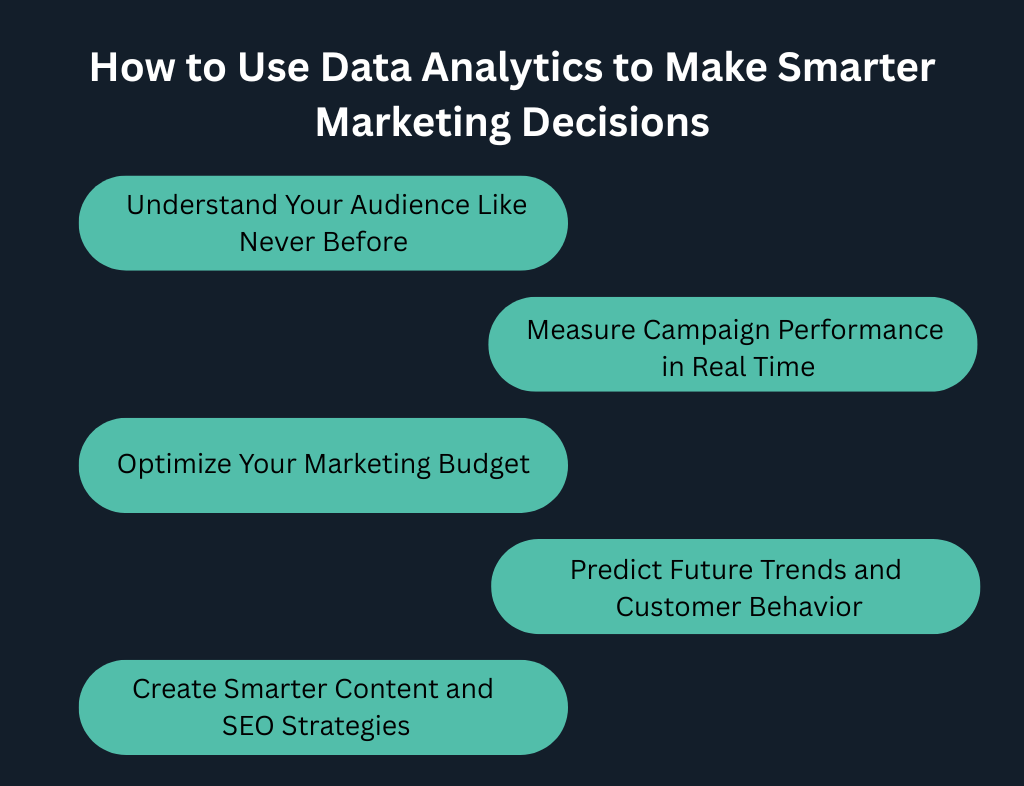In today’s digital world, guessing your next move isn’t enough. Every click, scroll, and share your audience makes leaves behind a trail of valuable data and when you learn how to analyze it, that data becomes your secret weapon.
That’s what data analytics in marketing is all about using real insights instead of assumptions to guide your marketing strategy. It helps you understand what’s working, what’s not, and how to connect better with your audience.
you can also read: How to Use Data Analytics to Make Smarter Marketing Decisions

Let’s explore how to use data analytics to make smarter, more confident marketing decisions that drive real results.
Understand Your Audience Like Never Before
Knowing your audience is the foundation of any successful campaign but thanks to analytics, you can now go beyond basic demographics.
Marketing analytics tools like Google Analytics or HubSpot help you see:
- Which devices your audience uses
- What pages they visit the most
- How long they stay on your website
- What type of content they engage with
This information allows you to build detailed customer personas based on actual behavior, not assumptions.
For example:
- If your visitors mostly browse on mobile, make sure your website and ads are mobile friendly.
- If a particular blog topic or video gets high engagement, create more content around that subject.
- If your Instagram followers are more active than Facebook users, prioritize your content strategy there.
When you truly understand your audience, your campaigns feel personal and that’s what drives conversions.
Measure Campaign Performance in Real Time
One of the biggest advantages of data-driven marketing is the ability to track results instantly. You don’t have to wait weeks to see what’s working you can know it right now.
Analytics tools let you monitor:
- Traffic sources (organic, paid, or social)
- Click through rates (CTR)
- Bounce rates and conversions
- Cost per lead and cost per acquisition
For example, if you’re running both Google Ads and Facebook Ads, analytics can show which one gives you better ROI. If Facebook is driving more qualified leads, you can shift your budget there.
Real time tracking also means you can adjust strategies immediately pausing poor performers and doubling down on what works.
Instead of guessing, you’re constantly learning and improving. That’s the magic of real time data.
Optimize Your Marketing Budget
No one wants to waste marketing dollars and analytics ensures you don’t.
By tracking numbers like ROI (Return on Investment), CAC (Customer Acquisition Cost), and LTV (Customer Lifetime Value), you can identify which campaigns are worth your budget and which aren’t.
For example:
- If you spend $300 on an ad campaign that brings five sales but $100 on an email campaign that brings ten, the data clearly tells you where to focus.
- If your organic blog posts consistently bring in leads for free, it might be smarter to invest more in content marketing.
Using data analytics in marketing helps you make smart, evidence based spending decisions. You’re not just spending you’re investing strategically.
Over time, this approach helps you scale efficiently and maximize ROI.
Predict Future Trends and Customer Behavior
Wouldn’t it be great if you could predict your customers’ next move?
Well, you can with predictive analytics.
By analyzing past data, marketers can identify trends and forecast what’s likely to happen next. For instance:
- If your sales spike during holidays or specific seasons, plan your promotions early.
- If customers who buy one product often return for another, use cross-selling or bundle offers.
Predictive analytics helps you move from reactive to proactive marketing. Instead of waiting to see what happens, you can act ahead of time.
Thanks to AI powered tools like Google Analytics 4 and HubSpot’s predictive lead scoring, even small businesses can use predictive models to anticipate customer needs and boost engagement.
Create Smarter Content and SEO Strategies
Your content is the voice of your brand and data analytics tells you how well it’s being heard.
By analyzing key performance metrics, you can find out:
- Which blog posts or videos drive the most traffic
- What keywords bring the best results
- How long people stay on each page
- Which topics generate conversions
For instance, if “how-to” guides consistently outperform product updates, that’s a clear sign your audience prefers educational content.
Tools like SEMrush, Ahrefs, and Google Search Console show which keywords are ranking, which aren’t, and how to improve.
When you use this data to shape your SEO and content strategy, you’ll attract the right audience and keep them coming back.
How to Fix
Many marketers collect tons of data but struggle to make sense of it. Here’s how to fix that:
- Start with clear goals. Know what success looks like before diving into the numbers.
- Track the right metrics. Focus on conversion rate, ROI, and engagement, not vanity metrics like likes or impressions.
- Clean your data regularly. Outdated or duplicate data leads to bad decisions.
- Visualize your data. Dashboards and charts make trends easier to understand.
- Act on your insights. Data means nothing if you don’t use it to make improvements.
When you treat data as a decision making tool not just information that’s when you’ll see real results.
Conclusion
Data analytics has turned marketing into both an art and a science.
Instead of relying on hunches, you now have hard evidence to back your decisions. You can understand your audience, measure what works, predict future trends, and use your budget more effectively.
But here’s the best part data doesn’t replace creativity; it enhances it.
When you combine smart insights with great ideas, you create campaigns that are not only creative but also effective.
So whether you’re running ads, writing blogs, or building an email list, remember: every marketing choice should be powered by data.
FAQs
What are the best tools for marketing data analytics?
Popular tools include Google Analytics 4, HubSpot, SEMrush, Ahrefs, and Tableau for deeper insights.
How often should I check my analytics?
Review key metrics weekly and perform full campaign evaluations monthly or quarterly.
Can small businesses benefit from analytics?
Absolutely! Even free tools like Google Analytics can help small businesses understand their audience and optimize campaigns.
What’s the difference between descriptive and predictive analytics?
Descriptive analytics explains what’s already happened. Predictive analytics forecasts what’s likely to happen next.
Do I need a data expert to start using analytics?
Not necessarily. Most modern analytics platforms are beginner-friendly and provide built-in reports that are easy to interpret.

